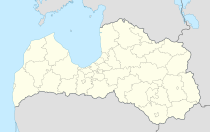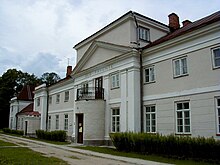Varakļāni
| Varakļāni ( German : Warkelen) | ||
|---|---|---|
 |
|
|
| Basic data | ||
| State : |
|
|
| Landscape: | Latgale ( Latvian : Latgale ) | |
| Administrative district : | Varakļānu novads | |
| Coordinates : | 56 ° 37 ' N , 26 ° 45' E | |
| Residents : | 1,893 (Aug 26, 2018) | |
| Area : | 5.33 km² | |
| Population density : | 355 inhabitants per km² | |
| Height : | 107 m | |
| City law: | since 1928 | |
| Website: | www.varaklani.lv | |
| Post Code: | 4838 | |
| ISO code: | ||
Varakļāni (German: Warkland or Warkelen ) is a small town in Latgale , in eastern Latvia . In 2018 it had 1893 inhabitants.
history
Varakļāni is mentioned for the first time in historical sources in 1483. At that time, Bernt von der Borch , who had to resign from his position as landmaster in Livonia that year , acquired the place and the Warkland estate.
Like Latgale as a whole, Varakļāni came under Polish-Lithuanian sovereignty through the Treaty of Altmark in 1629 . As a result of the First Partition of Poland , Latgale fell to the Russian Empire in 1772 . At the beginning of the 19th century, Varakļāni, despite its small population, was referred to as the “city”. Because it was important as a market place for the surrounding area. In 1860 Varakļāni had 716 inhabitants. The Jewish community in Varakļāni was one of the largest Jewish communities in Latgale until 1941.
Varakļāni has been part of independent Latvia since 1918. Varakļāni achieved the formal status of a town in 1928. Varakļāni was the seat of a deanery , which in 1940 included nine parishes with a good 30,000 Catholics.
During the Second World War , the commander of the Rear Army Area North (Berück Nord), Franz von Roques , ordered one of the 18 ghettos for the Latvian Jews to be set up in Varakļāni on August 28, 1941. The majority of the Jewish citizens of Varakļāni had already been rounded up and shot on August 3, 1941, one month after the capture by the 6th Panzer Division on July 1, 1941.
During the conquest by the Red Army in 1944, Varakļāni was badly damaged.
Administrative history
Varakļāni was part of the following administrative units:
- 1772–1919: Vitebsk Governorate , Rēzekne District
- 1919–1950: District ( Latvian apriņķis ) Rēzekne
- 1950–1956: Varakļāni Rajon
- 1956–1963: Viļāni Rajon
- 1963-2009: Madona district
- 2009–2020: District ( Latvian novads ) Varakļāni
As a result of the falling population, the dissolution of the Varakļāni district is planned (as of March 2020). The city of Varakļāni is said to be assigned to one of the two neighboring districts, Madona or Rēzekne. In a referendum in February 2020, 933 citizens (84%) voted to join the Madona district and 174 citizens (16%) to join the Rēzekne district.
Buildings
lock
In the years from 1783 to 1789, Count Michael von der Borch had a manor house built to this day as a "castle" (Latvian: pils) based on a design by the Italian architect Vincenzo de Mazotti (1756–1798). The Varakļāni Castle is considered to be one of the outstanding buildings of early classicism in Latvia. On the facade of the three-part central building on the 100 m long south side, the client had his motto written in Latin: “Virtute duce - Deo favente - Comite fortuna” (guided by virtue - with God's favor - accompanied by luck). The inscription is both a play on words and a small bow by the count ( comes ) to the duke ( dux ) of Courland , whose family was linked to the von der Borch family for generations.
The von der Borch family lived in the castle until 1920. During the renovation in the 1990s, parts of the original wall paintings from the 1780s were exposed and restored. The local history museum has been housed in the castle since 1997.
The castle is surrounded by extensive parks and ponds through which the Kažava flows. Count Michael von der Borch set a literary monument in his park with a long poem, which was given to the Polish king in 1791 and published in a revised version in 1795 : " Jardin sentimental du château de Warkland dans le Comté de Borch en Russie Blanche ".
St. Viktor Chapel
As the burial place of those von der Borch, the widow of Count Michael von der Borch, Countess Eleonore Christina von Browne of Camas (1766-1844), the daughter of the Governor General of Livonia , Georg Browne , left a rotunda in 1814 on a small hill in the west of the village , build the St. Viktor Chapel.
Churches
Count Karl von der Borch had the large, three-aisled parish church of St. Mary's Assumption built for the Catholic parish in the classicist style; it was consecrated in 1854 after three years of construction.
At the end of the 19th century, an Evangelical Lutheran church was built in Varakļāni. It burned down when the Soviet troops attacked it in 1944. At the beginning of the 21st century it was renewed and is now used again for church services.
sons and daughters of the town
- Michael Johann von der Borch (1753-1810), German-Baltic writer and scientist, royal Polish lieutenant general and quartermaster general in the Grand Duchy of Lithuania
- Anton (s) Kokars (* 1922, † 2006 in Northeim ), journalist and writer, volume of poems "Svešumā" ( In the Foreign ) 1958
- Antons Justs (1931–2019), Catholic clergyman, Bishop of Jelgava
- Rita Strode (born July 26, 1955), politician, member of the Saeima
- Ilmārs Latkovskis (born December 4, 1958), politician, member of the Saeima
Varakļānu novads
Since 2009, the city of Varakļāni has formed the administrative district of Varakļāni (Varakļānu novads) with the rural community of Varakļāni and the neighboring municipality of Murmastiene. (See also: Administrative division of Latvia ).
In 2016, a total of 3310 inhabitants were registered. At the 2011 census, 93.3% of them declared themselves to be ethnic Latvians, 4.9% said they belonged to the Russian minority and 1.8% of other ethnic minorities.
literature
- Art. Varakļāni . In: Astrīda Iltnere, Uldis Placēns (Red.): Latvijas pilsētas. Enciklopēdija . Preses Nams, Riga 1999, ISBN 9984-00-357-4 , pp. 542-546.
- Art. Varakļānu pagast . In: Astrīda Iltnere (Red.): Latvijas Pagasti. Enciklopēdija . Preses Nams, Riga 2002, ISBN 9984-00-436-8 , Vol. 2: M-Z , pp. 558-560.
- Konrads Sondors: Varakļāni un Varakļāniesi . Latgales Kulturas centra izdevnieciba, 2002.
Web links
- Varakļāni in the database of place names ( Vietvārdu datubāze ) of the Latvijas Ģeotelpiskās informācijas aģentūra (LGIA), edition of September 30, 2015, with extensive local information (Latvian), accessed on June 25, 2016.
- Information from a Latvian Internet travel guide
Footnotes
- ↑ a b Latvijas iedzīvotāju skaits pašvaldībās (= population figures of the self-governing districts of Latvia), as of July 1, 2018 (Latvian), p. 20, accessed on December 18, 2018.
- ^ Albert Bauer (Red.): Files and recesses of the Livonian Estates , Vol. 2: 1460–1494 , published by the Society for History and Archeology in Riga. E. Bruhns publishing house, Riga 1938, p. 105.
- ↑ Reinhard Wittram: Baltic history. The Baltic countries of Livonia, Estonia, Courland 1180–1918 . Scientific Book Society, Darmstadt 1973. ISBN 3-534-06475-5 . P. 87.
- ↑ Adam Christian Gaspari , Johann Georg Heinrich Hassel , Johann Günther Friedrich Cannabich : Complete and most recent description of the earth of the Russian Empire in Europe along with Poland, with an introduction to the statistics of the entire Russian Empire . Verlag des Geographisches Institut, Weimar 1821, p. 728.
- ↑ ACA Friederich: Historical-geographical representation of old and new Poland . Stuhr'sche Buchhandlung, Berlin 1839, p. 499.
- ↑ Eduard Heinrich Busch: Materials on the history and statistics of the church and school system of the Ev.-Luth. Parishes in Russia . Haessel, St. Petersburg 1862, p. 432.
- ↑ Makss Kaufman: Churbn Latvia. Ebreju iznīcināšana Latvijā . Shamir, Riga 2014, ISBN 978-9934-8494-0-4 , p. 232.
- ↑ Ernst Benz : The Roman Catholic Church in Latvia 1918–1940 . In: Boris Meissner , Dietrich André Loeber , Detlef Henning (eds.): The German ethnic group in Latvia during the interwar period and current issues of German-Latvian relations . Bibliotheca Baltica, Tallinn 2000, ISBN 9985-800-21-4 , pp. 162-174, here p. 170.
- ↑ Karl Heinz Gräfe: From the thunder cross to the swastika. The Baltic States between dictatorship and occupation . Edition Organon, Berlin 2010, ISBN 978-3-931034-11-5 , p. 256.
- ↑ Memorial stone in Yiddish on the Jewish cemetery in Varakļāni.
- ↑ Kultūršoks: Vai varakļānieši nodod latgalisko identitāti? , Latvijas Televīzija , March 6, 2020 (Latvian), accessed March 9, 2020.
- ↑ Viedokļiem daloties, izvēlas Madonas novadu , February 18, 2020 (Latvian), accessed March 9, 2020.
- ↑ Jolanta Polanowska: Michał Jan Borch and His Residence in Varakļāni: Genesis and ideological program . In: Mākslas Vēsture un Teorija , vol. 16 (2013), pp. 18–32.
- ↑ Apskates objekti Varakļānu pilsētā ( Sights in the city of Varakļāni , Latvian), accessed on August 14, 2015.
- ↑ Meeting reports of the Courland Society for Literature and Art from the years 1864 to 1871 . Mitau 1884, p. 172.
- ↑ Jānis Zilgalvis: Varakļāni - muiža un tas saimnieki gadsimtu gaitā (translation of the Latvian title: Varakļāni - the manor house and its owners over the centuries ). In: Mākslas Vēsture un Teorija , vol. 16 (2013), pp. 33–36 (Latvian).
- ^ Jolanta Polanowska: The Palace Garden in Warklany. Work of the Owner Michał Jan Borch and Architect Vincenzo de Mazotti . In: Biuletyn Historii Sztuki , vol. 74 (2012), issue 3/4, pp. 3–5.
- ↑ Johann Friedrich von Recke , Charles Edward Napiersky , Theodor Beise : General Writers and Scholars Lexicon of the provinces of Livonia, Esthonia and Kurland , Vol. 1: A-F . Johann Friedrich Steffenhagen and son, Mitau 1827, pp. 219–223, here p. 223 (online) .
- ↑ Central Statistical Office of the Republic of Latvia: Results of the census in 2011 ( Memento of the original from July 1, 2018 in the Internet Archive ) Info: The archive link was inserted automatically and has not yet been checked. Please check the original and archive link according to the instructions and then remove this notice. , P. 110, accessed on July 7, 2016 (Latvian and English).


